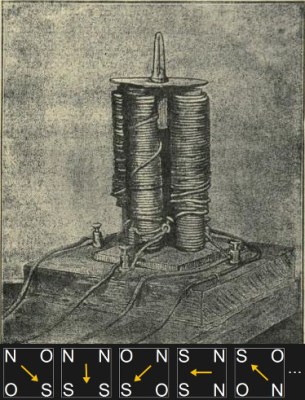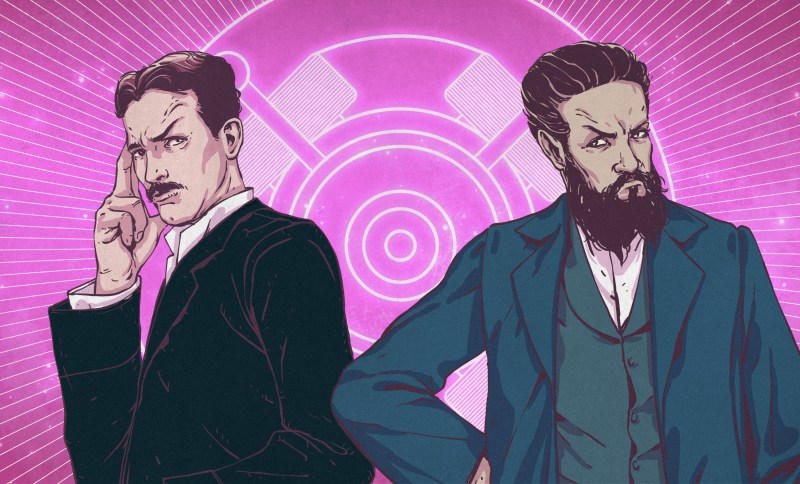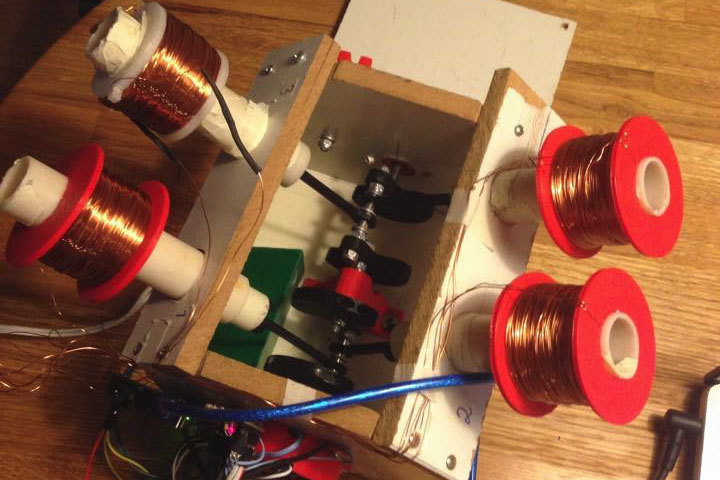When you think of who invented the induction motor, Nikola Tesla and Galileo Ferraris should come to mind. Though that could be a case of the squeaky wheel being the one that gets the grease. Those two were the ones who fought it out just when the infrastructure for these motors was being developed. Then again, Tesla played a huge part in inventing much of the technology behind that infrastructure.
Although they claimed to have invented it independently, nothing’s ever invented in a vacuum, and there was an interesting progression of both little guys and giants that came before them; Charles Babbage was surprisingly one of those giants. So let’s start at the beginning, and work our way to Tesla and Ferraris.
Arago’s rotations (1824-1831)
The induction motor’s invention began in 1824 in Paris with the publication of a very simple series of observations by François Arago. He suspended a magnetic compass needle laying horizontally in the middle of rings of different materials. He then rotated the needle 45° and let go of it. The needle proceeded to swing back and forth, with the maximum angle of its swing gradually decreasing. Arago counted the number of swings before the angle decreased to 10°. With a wooden ring, it took 145 swings, with a thin copper ring it took 66, and in a stout copper ring it took only 33 swings. The presence of the copper somehow dampened the oscillations of the needle.

Others followed that lead and in 1825 Charles Babbage and Charles Herschel demonstrated an experiment wherein they spun a magnet under a copper disk and caused the disk to spin briskly. They also cut slits radially in the disk and observed that this diminished the effect. Attempting to quantify the effect of the radial slits, they found that if they assigned a value of 100 to the rotary force of an unslit disk, then a disk with one slit had a value of 88, two was 77, four was 48 and eight was 24. Just as with Arago’s compass needle, the magnetic object was again somehow interacting with the non-ferromagnetic material.
In 1831, Faraday did his own experiments and came up with the explanation for the effect that we still use today. Eddy currents were induced in the copper from the relative motion between the magnet and the copper disk. These eddy currents formed in such a way as to create magnetic fields of their own. The interaction of the two magnetic fields push or pull on the disk, making it rotate with the magnet or slowing down if the magnet isn’t moving.
Many more experiments were performed between 1824 and 1831, as well as in the years following, however, they all involved rotating either the magnet or the copper disk. The next big step forward was to find a way to rotate the magnetic field without rotating either physical object.
Walter Baily (1879)

On June 28, 1879, Walter Baily demonstrated his own Arago’s rotations experiment. In it, he replaced the permanent magnet with four electromagnets. But instead of rotating the electromagnets, their magnetic polarities were alternated electrically in order to create the rotating magnetic field. A hand cranked commutator fed by two batteries controlled the currents running through the electromagnets. Such a battery and commutator system meant that the currents going to the electromagnets were not sine waves, but rather closer to square waves, not ideal for smooth rotation.
The cycling of the magnets were as shown. The letters indicate the poles facing the disk, with O indicating when the electromagnet was off. The arrow shows the direction from north to south and can also be replaced by the copper disk, making clear how it would rotate. This is a lot like the drive mode of a modern stepper motor, but remember that instead of pulling against permanent magnets, the rotating magnetic field is pulling against the field caused by induced eddy currents.
And that brings us to the dawn of the modern induction motor and Galileo Ferraris.
Galileo Ferraris (1885)

In 1885, Galileo Ferraris demonstrated an induction motor that also involved using two pairs of electromagnets to create a rotating magnetic field, though he did this independently of Baily. His motor more closely resembled modern ones in that the electromagnets surrounded a cylinder. More significantly, however, he proposed creating a true rotating magnetic field for it by supplying two sine wave alternating currents 90° apart. He gave his first public demonstration of the motor in 1888.
Also, in March 1888 he published Electrodynamic rotations produced by means of alternate currents wherein he showed a method for producing those 90° out-of-phase currents. See Figure 92 in the diagram. This would be done by supplying the electromagnets with branches from the same AC source. One branch would have resistance but no self-inductance and the other would have a small resistance but a high self-inductance. These would then feed the windings of the coils. He then described how he’d succeeded in doing experiments along those lines in 1885. In April 1889, Nikola Tesla described this same method of splitting the phase but only to be used for starting a synchronous motor (more on synchronous motors later).
Nikola Tesla (1882 or 1887)

And speaking of Nikola Tesla, he claims to have thought of the idea of the rotating magnetic field one afternoon in 1882 while walking in a park. But it wasn’t until November 1887 that he filed his first patent for an induction motor, and the patent wasn’t granted until May 1888. That was US patent 382,279, Electro-magnetic motor. Figure 1 from that patent is shown here. The motor is at the top and an AC generator is at the bottom.
In those overlapping dates of the Italian Ferraris’ and Serbian Tesla’s, lies a dispute which exists to this day. Ferraris made and demonstrated his motor in 1885 but not publicly until 1888. Whereas Tesla thought of the idea in 1882 but didn’t file a patent until 1887. Both claimed to have come up with the idea for the rotating magnetic field independently, and that’s not unusual when many experimenters are working on similar problems, all with the same novel technology.
Tesla’s patent points out that the rotor rotates more slowly than the stator’s magnetic field. Though not a new finding, it’s an interesting and necessary feature of induction motors. In order for a magnet’s magnetic field to induce current flow in a material like copper, for example, there has to be a relative motion between them. If the magnetic field and the copper rotor are rotating at the same speed then there is no relative motion and the rotor will slow down. That slowing down creates a relative motion and current is induced, speeding up the rotor. Basically, when the motor is first powered, i.e. the rotating magnetic field is first applied, the rotor begins to rotate. Its speed increases until a balance is found between the induced current and thus torque, and the mechanical load.
The ratio of the speed of the magnetic field being applied to the rotor, to the speed of the magnetic field created by the induced current is called slip. This difference in speeds is why an induction motor is often called an asynchronous motor. A type of motor where the speeds are the same, or synchronized, is called a synchronous motor.
Another interesting feature of the motor in Figure 1 of Tesla’s patent is that rather than using copper plates in the rotor, Tesla uses copper coils in closes loops. You can see that the rotor is made up of two pieces, fixed at 90° to each other. The bulk of the two pieces are soft iron but each has a coil wrapped around it. The coils are simply closed loops and it’s in these coils that the current is induced and it’s from them that the magnetic field is formed.
Closing Our Own Loop
While that was the invention of the induction motor, it was by no means the end of its development. We could talk about wound type motors vs. squirrel cage motors, different starting methods, speed control and more. This was now the dawning of the electrical age with power grids springing up all over the world, and the induction motor was just one of a multitude of new types of electric devices. So instead we’ll direct you to our [Bryan Cockfield]’s article demystifying the power grid, or perhaps you’d like to read up on Nikola Tesla’s collisions with Thomas Edison, or about Edison’s involvement in inventing the lightbulb.

















Stator does not rotate at all, by definition.
Thanks. Silly mistake made by me when editing and trimming. Fixed.
Sir you have done a great job writing this article.But I want to inform you about some important matter
.That is Nikola Tesla’s first induction motor was invented in the year 1883.Full description of this motor can be found in Bernard Carlson’s book’ Tesla inventor of electrical age’.The second point is that Tesla’s first induction motor patent was US381,968 and not US382,279.The first patent on induction motor was filed in october 12,1887.This patent clearly describes a Three phase induction motor also(see patent diagram) Sir therefore I beleive that you should include above mentioned points after verifying my findings.
You are correct. This is the mistake in the article. It is supposed to say “… the rotor rotates more slowly than the stator field.” I hope they fix it.
I should have refreshed the page one more time before posting :)
Tesla made a working prototype of his induction motor in 1882 (or thereabouts), while working in Hungary (Budapest). It took him several years of work in various European nations until he immigrated to the USA. That is why the patent is from 1888.
In his Colorado notes he claims he envisioned it even before then while still a student in Croatia.
Tesla has NOT a single empirical proof that he invented it in Budapest or Strasbourg. These are Tesla’s gross lies. tesla lied recklessly, even in his autobiography. He claimed that he could hear lightning at a distance of 550 miles, that he had a heart on his right side, that he saw a huge light in the eyes of a pigeon, etc.). The inventor of the induction motor and the rotating magnetic field was Gaelileo Ferraris and this was claimed by all the key people of the 19th century in the world of technology and science. William Stanley, one of America’s earliest AC pioneers: “All foreign scientific publications speak of the Ferraris motor, the Ferraris principle and the Ferraris system, for he invented , constructed, and described his work several years before Mr. Tesla claims to have devised it.” At the Electrotechnical Congress in 1892 in Frankfurt, Physicist Galileo Ferraris was proclaimed “the father of three-phase current “, and Inventor of the Induction Motor. Tesla does NOT have a single key invention: http://edisontechcenter.org/tesladebunked.html
You forgot what came immediately before the rotary electric motor… it seems linear motion via coil was easier to generate. The term you’re looking for is “solenoid engine” and it works about how you’d expect — like a stationary steam engine with the cylinder replaced by a solenoid.
Generating the 90° apart thing for example.
That’s what Jules Verne’s roughly described as the main motor of “Nautilus” in “Twenty Thousand Leagues Under the Sea”.
It was in 1870. How fast technology obsoleted some good SciFi of its time!
A good book, I should read it again.
Do you mean like this from https://hackaday.com/2016/02/19/home-made-solenoid-motor/?

…sort of. But more like the one pictured here (http://electro-magnetic.webs.com/history.htm) in the section titled “Charles Grafton Page”…
I’d love to build a solenoid engine of my own — I’ve got the flywheel, a spare car rim 16” in diameter — but I need a big, big solenoid to spin that. Anyone know where I can get a solenoid with a one-inch throw? :D
Nice website!
Roll your own? Or order it from China :-)
Old idea:
https://de.wikipedia.org/wiki/Egger-Elektromotor
That’s exactly what I was trying to point out… please read (or re-read) my comment…
Probably mostly because the engineers were accustomed to the linear motion of the piston of a steam engine. A rotary “steam-motor” would require some difficult seals, although rotary hydraulic motors exist these days.
Actually, it’s because DC was the first invented electricity, and linear motion is operated quite efficiently with a DC pulse (dead time in rotation) via mechanical timing. Moving to AC came with the advent and installation of the Dynamo, or AC generator…to which Tesla created and helped install across the nation (Edison vs Tesla, DC vs AC transmission lines). The linear motion and DC motors in general were phased out in industry because of destructive back-emf sparks in commutators (see Tesla patents on mica insulated brushes and contacts).
I’m sorry, but what Khal Drogo doing on this picture?
:-) That’s his twin brother, Galileo Ferraris. You can see him here when not in a competitive mood https://en.wikipedia.org/wiki/Galileo_Ferraris.
So, all in all, it took some 50 years to develop an induction motor with the found eddy currents.
That’s a long time.
Not when you realize that electricity was first discovered in DC form and the Homopolar generator, Van de Graaff generator, and/or batteries was what everyone was experimenting with. It seems utterly obvious now, but it took the invention of AC, and the realization that a certain geometry of AC driven coils would create a magnetic vortex. After all, it was Tesla who won the DC vs AC war with Edison. All motors and generators at the time before AC induction motors had brushes and commutators…Also, is it even a question as to who invented it? LOL, Tesla went on to create the brushless AC Dynamo and help install them across the U.S.A. The AC dynamo is the reverse of the AC induction motor “Everything in physics is scale-able and reversible” (someone who actually invented it would see this…and Tesla did). It took J.P. Morgan’s $$…as Tesla envisioned it as a student in Croatia, and built one while working in Budapest, and finally patented it in America with Morgan’s help…to which Morgan ultimately held all the rights to (and almost all of Tesla’s patents), and why Tesla died a relatively poor man in N.Y.
We probably have Almarian W. Decker more to thank than Tesla for our infrastructure today. He created the first three phase hydroelectric plant that is the basis of what we use today and predates Tesla’s Niagara plant. This was at the Mill Creek #1 plant in Redlands, California.
http://www.hydroworld.com/content/dam/hydroworld/site-images/2106_HallofFame.pdf
Love those historical/bacground articles.
And now pardon me for being a grammar OCD: it’s “effect”, not “affect” in “Attempting to quantify the affect of the radial slits…”
Fixed. Thanks. That’s one I’m usually very careful about — though I have to think about it each time.
Glad to hear you enjoy these. They’re fun to research and write.
> That’s one I’m usually very careful about
Well, shit happens. I’m always appalled when I read through things I wrote, after some time of cooling down. So I’m always happy when someone points out those slips to me.
> Glad to hear you enjoy these.
Most definitely!
Plz give me one chance
The man that brought the most clarity to this whole topic is Charles Proteus Steinmetz. He is recognized as the father of modern electrical engineering and was pivotal in the development of reliable AC technology. He was General Electric’s lead engineer and was said to be one of the few men that truly understood Einstein’s General Theory of Relativity when it was first published.
If you read Tesla’s Colorado notes, he had the vision for the induction motor while on public transit while looking to the sun (not walking in the park lol). He envisioned the sun as a giant magnetic vortex, he then realized an iron core inside the vortex would be induced to spin…shortly after he brought the induction motor to reality.
It’s been a long time since I read it, but if iirc, he was still studying in Croatia when he envisioned it (it was purely theoretical…many people don’t realize a sinusoidal wave (AC wave form) is a graph of a circle with a time component), and it wasn’t until he went to America and hooked up with J.P. Morgan that he had funds to build and patent it.
My source is the Tesla biography “Tesla: Man Out of Time” by Margaret Cheney pages 22-24.
“Tesla’s Colorado notes” were written by Tesla and later published…he recounts his inception of the induction motor in it, in his own words ;)
Tesla claimed to communicate with martians and of being capable to hear thunderbolts at 500 miles. Not really a trustworthy guy….
Galileo Ferraris gave the public demonstration of AC motor in 1885, not 1888.